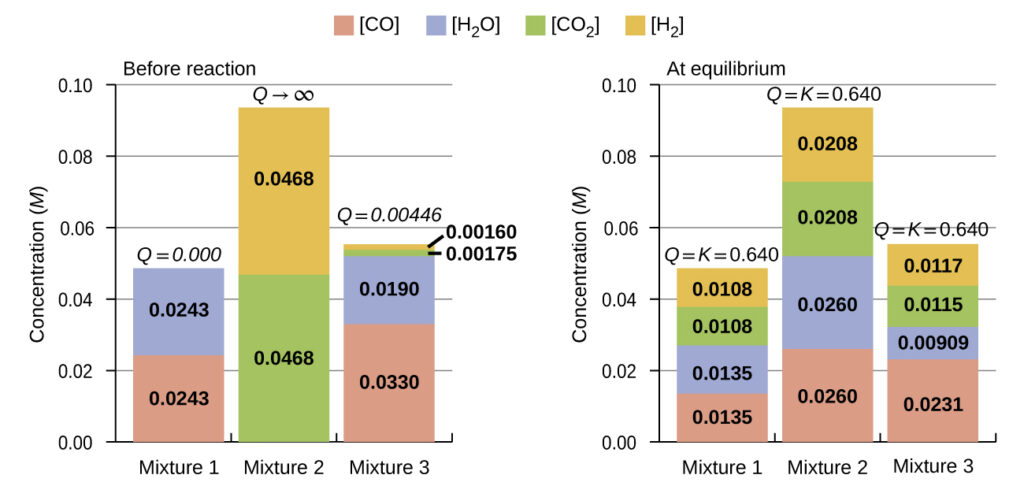By its definition, the magnitude of an equilibrium constant explicitly reflects the composition of a reaction mixture at equilibrium, and it may be interpreted with regard to the extent of the forward reaction. A reaction exhibiting a large K will reach equilibrium when most of the reactant has been converted to product, whereas a small K indicates the reaction achieves equilibrium after very little reactant has been converted. It’s important to keep in mind that the magnitude of K does not indicate how rapidly or slowly equilibrium will be reached. Some equilibria are established so quickly as to be nearly instantaneous, and others so slowly that no perceptible change is observed over the course of days, years, or longer.
The equilibrium constant for a reaction can be used to predict the behavior of mixtures containing its reactants and/or products. As demonstrated by the sulfur dioxide oxidation process described above, a chemical reaction will proceed in whatever direction is necessary to achieve equilibrium. Comparing Q to K for an equilibrium system of interest allows prediction of what reaction (forward or reverse), if any, will occur.
To further illustrate this important point, consider the reversible reaction shown below:
$$CO\mathit (g) + H_2O\mathit (g) ⇌ CO_2\mathit (g) + H_2\mathit (g) \qquad Kc=0.640 \quad T=800°C$$
The bar charts in the figure below represent changes in reactant and product concentrations for three different reaction mixtures. The reaction quotients for mixtures 1 and 3 are initially lesser than the reaction’s equilibrium constant, so each of these mixtures will experience a net forward reaction to achieve equilibrium. The reaction quotient for mixture 2 is initially greater than the equilibrium constant, so this mixture will proceed in the reverse direction until equilibrium is established.

Predicting the Direction of Reaction
Given here are the starting concentrations of reactants and products for three experiments involving this reaction:
Determine in which direction the reaction proceeds as it goes to equilibrium in each of the three experiments shown.
| Reactants/Products | Experiment 1 | Experiment 2 | Experiment 3 |
|---|---|---|---|
| [CO]i | 0.020 M | 0.011 M | 0.0094 M |
| [H2O]i | 0.020 M | 0.0011 M | 0.0025 M |
| [CO2]i | 0.0040 M | 0.037 M | 0.0015 M |
| [H2]i | 0.0040 M | 0.046 M | 0.0076 M |
Solution
Experiment 1:
Qc < Kc (0.040 < 0.64)
The reaction will proceed in the forward direction.
Experiment 2:
Qc > Kc (140 > 0.64)
The reaction will proceed in the reverse direction.
Experiment 3:
Qc < Kc (0.48 < 0.64)
The reaction will proceed in the forward direction.
Check Your Learning
Determine the direction in which each of the following reactions will proceed to reach equilibrium.
(a) A 1.00-L flask containing 0.0500 mol of NO(g), 0.0155 mol of Cl2(g), and 0.500 mol of NOCl: $$2\, NO\, (g) + Cl_2\, (g) \rightleftharpoons 2\, NOCl\, (g) \qquad K_c=4.6×10^4$$
Answer
$$Q_c = \frac{[NOCl]^2}{[NO]^2 [Cl_2]} \\ Q_c = \frac{[\frac{0.500\text{ mol}}{1\, \text{L}}]^2}{[\frac{0.0500\text{ mol}}{1\, \text{L}}]^2 [\frac{0.0155\text{ mol}}{1\, \text{L}}]} \\ Q_c = 6.45 \times 10^{-3} \\ Q_c < K_c \\ \mathbf{\text{reaction proceeds forwards (}\rightarrow)}$$
(b) A 5.0-L flask containing 17 g of NH3, 14 g of N2, and 12 g of H2:
$$N_2\, (g) + 3\,H_2\, (g) \rightleftharpoons 2\,NH_3\, (g)\qquad K_c=0.060$$Answer
$$Q_c = \frac{[NH_3]^2}{[H_2]^3 [N_2]} \\ Q_c = \frac{\left[\frac{17\text{ g }NH_3 \frac{14.04\, \text{g}}{1\, \text{ mol }NH_3}}{5\, \text{L}}\right]^2} {\left[\frac{12\text{ g }H_2 \frac{2.02\, \text{g}}{1\, \text{ mol }H_2}}{5\, \text{L}}\right]^3 \left[\frac{14\text{ g }N_2 \frac{28.02\, \text{g}}{1\, \text{ mol }N_2}}{5\, \text{L}}\right]} \\ Q_c = 0.23 \\ Q_c > K_c \\ \mathbf{\text{reaction proceeds in reverse (}\leftarrow)}$$
(c) A 2.00-L flask containing 230 g of SO3(g):
Answer
$$ Q_c = \frac{[SO_2]^2 [O_2]}{[SO_3]^2} \\ \; \\ Q_c = \frac{0^2 \times 0}{\left[ \frac{230\, \text{g}\, SO_3 \times \frac{1\,\text{mol}\, SO_3}{80.06\, \text{g}}}{2.00\, \text{L}}\right]^2} \\ Q_c = 0 \\ Q_c < K_c \\ \mathbf{\text{reaction proceeds forwards (}\rightarrow)}$$